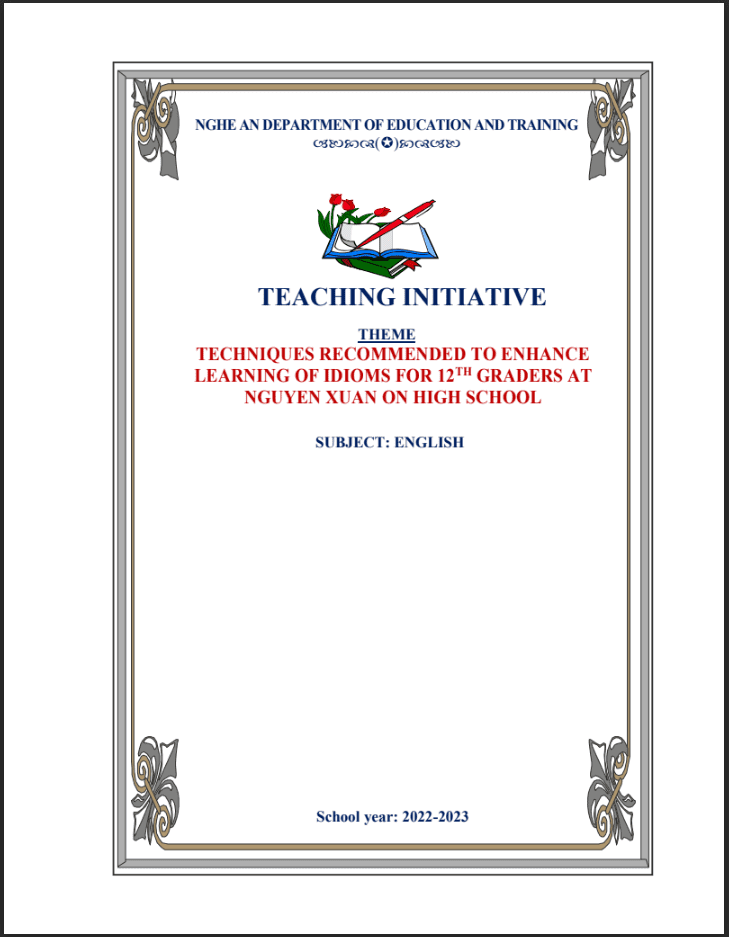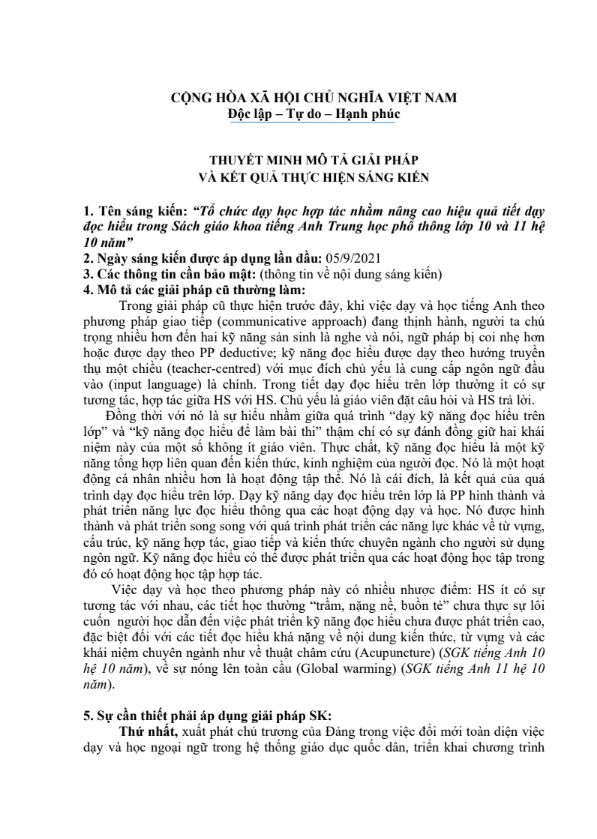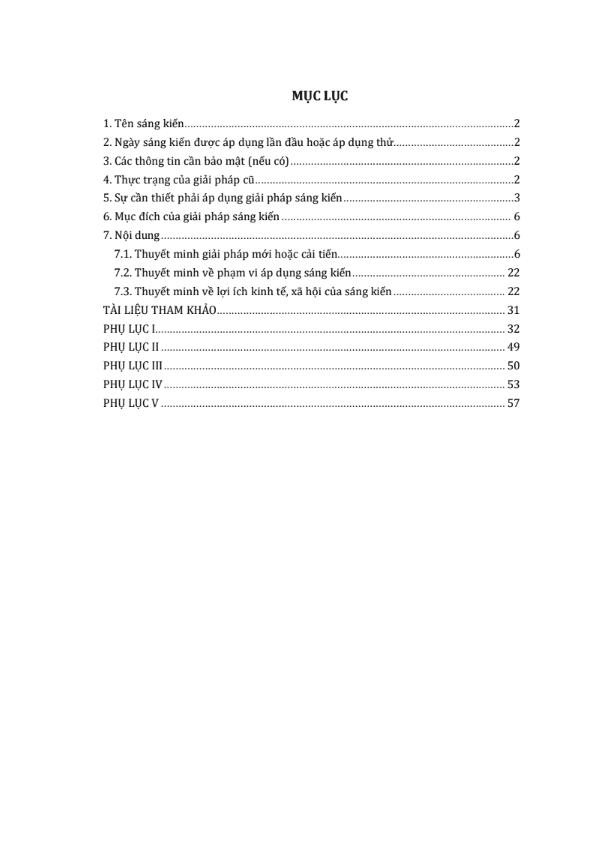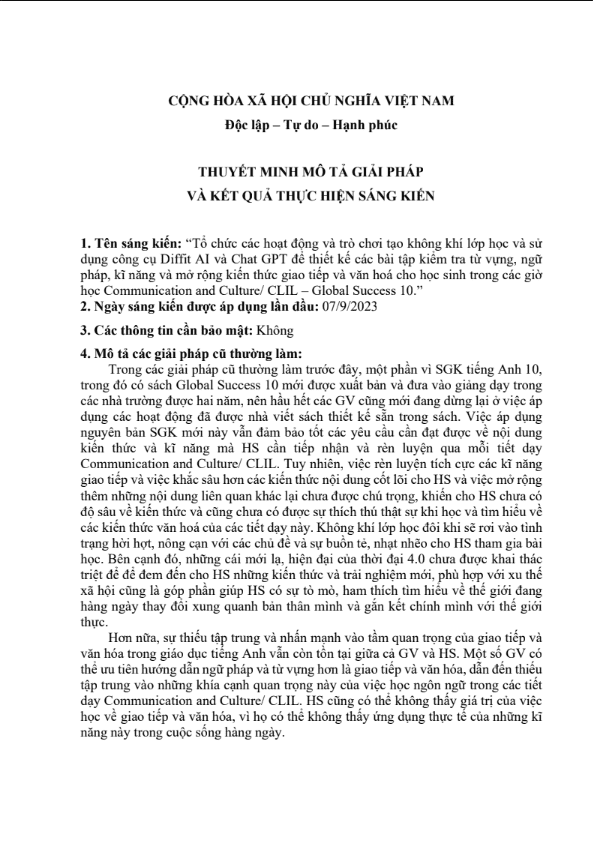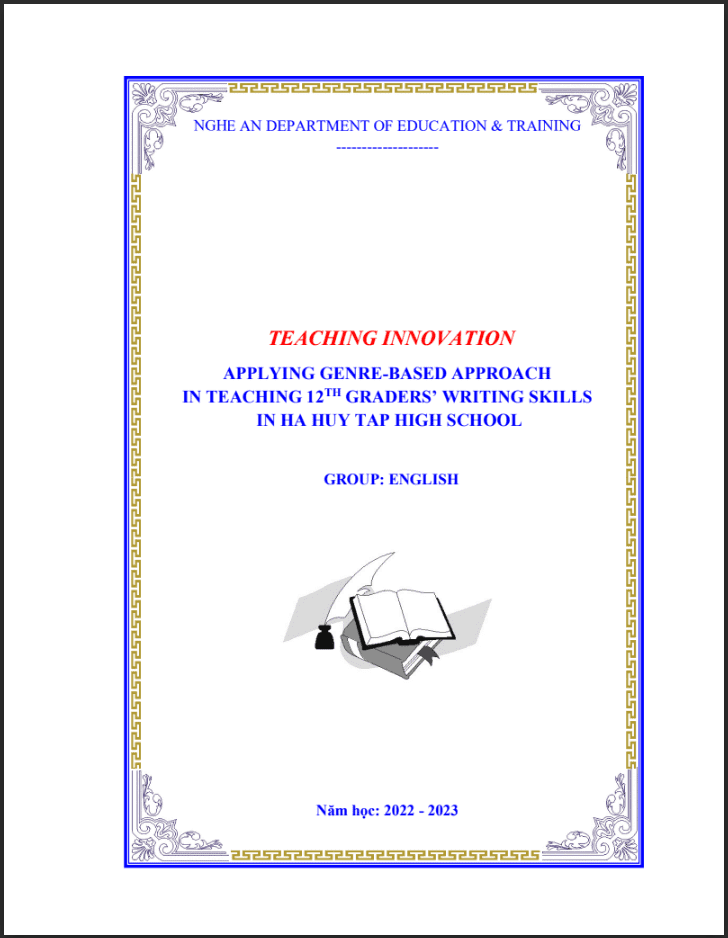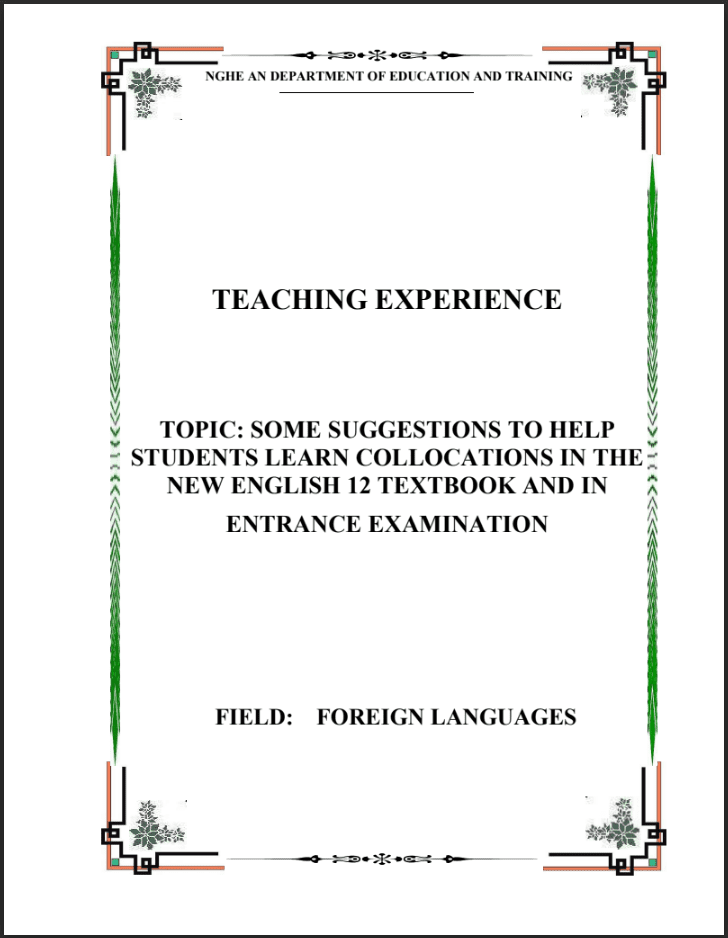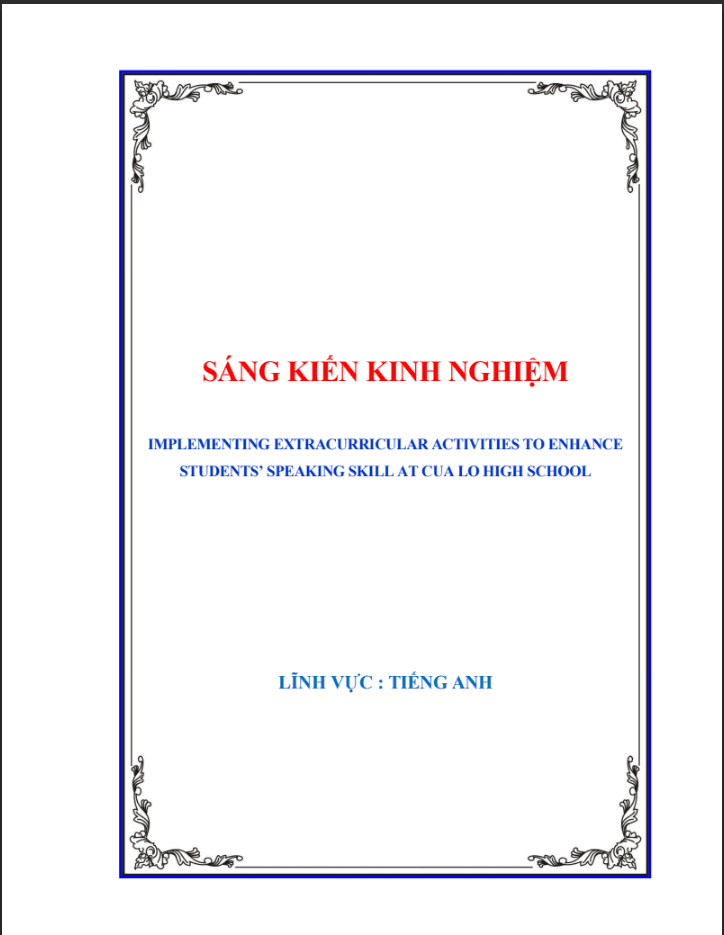SKKN Techniques recommended to enhance the learning of idioms for 12th graders at High School”
- Mã tài liệu: MP0110 Copy
| Môn: | Tiếng Anh |
| Lớp: | 12 |
| Bộ sách: | |
| Lượt xem: | 538 |
| Lượt tải: | 0 |
| Số trang: | |
| Tác giả: | Bùi Thị Thu Huyền |
| Trình độ chuyên môn: | Cử nhân đại học |
| Đơn vị công tác: | THPT Nguyễn Xuân Ôn |
| Năm viết: | 2022-2023 |
| Số trang: | |
| Tác giả: | Bùi Thị Thu Huyền |
| Trình độ chuyên môn: | Cử nhân đại học |
| Đơn vị công tác: | THPT Nguyễn Xuân Ôn |
| Năm viết: | 2022-2023 |
Sáng kiến kinh nghiệm “Techniques recommended to enhance the learning of idioms for 12th graders at High School””triển khai gồm các biện pháp nổi bật sau:
Mô tả sản phẩm
- INTRODUCTION
1
.1. Rationale
There is no denying that English is a crucial language in the modern world. The number
of people learning English has substantially increased over the past few decades.
English is the only language used by everyone to stay up with technological
breakthroughs in the age of computers. Because of this, more people are interested in
learning English, and parents are letting their children connect with the language from
an early age in all skill sets. The children must equally master speaking, listening,
writing, and reading, the four fundamental skills. One thing is necessary for kids to
acquire all skills: vocabulary, which is regarded as the building block of language.
Vocabulary is the foundation or core of learning any foreign language in order to
facilitate communication, as demonstrated by practice. Without a vast vocabulary,
learners will not be able to communicate or convey their thoughts effectively.
Vocabulary learning thus becomes extremely important and necessary for both
teachers and pupils. Idioms are a part of the vocabulary. An idiom is a term that is
frequently used in language to express certain sincere notions. These words are crucial
for expressing original ideas and bolstering the assertion. Additionally, it results in a
deeper comprehension of the language. Idioms and phrases are frequently used in
various competitive tests because of this. The variety of English idioms may initially
confound students. It is a known fact that kids find it quite difficult to take
examinations, especially high school exams, because they are extremely hesitant to
acquire new words and idioms and because their vocabulary appears to be very little.
As a result of the aforementioned fact, teachers must develop novel approaches and
discoveries to raise the standard of instruction and assist students in making
substantial advancements in their use of the language in authentic situations.
From my teaching experience, I see that 12th-grade students at Nguyen Xuan On
High School, as well as other Vietnamese students, face significant challenges in
learning and practicing Idioms. Due to a lack of professional expertise and adequate
learning methods, they frequently become confused when doing idioms questions. As
a result of the foregoing, I’ve come up with the concept of conducting an investigation
into these issues and offering different techniques to make improvement the current
situation. Hopefully, the study, titled “Techniques recommended to enhance the
learning of idioms for 12th graders at Nguyen Xuan On High School” may help
people who have struggled with or become bored with learning idioms in the future.
1
.2. Aim of the study
The goal of this experimental study is to determine a basic understanding of Idioms
and other related topics. My study’s specific goals are as follows:
–
–
Getting a base on Idioms
Studying learning Idioms of 12th graders at Nguyen Xuan On High School and
finding out the encountered difficulties in learning idioms.
1
–
Recommending some more effective and acceptable techniques for students to use
the right idioms in the right situations.
1
.3. Research questions:
In order to achieve the above-stated aim, this action research project was designed
and conducted to answer the two following questions:
1
2
1
. What difficulties do 12th graders face when learning idioms?
. What are the techniques used by 12th graders to deal with those problems?
.4. Scope of the study:
Although English idioms are a fantastic treasure to discover for the benefits it brings,
they are widely regarded as one of the most difficult subjects for English learners to
master, requiring a significant amount of time and effort to research. In addition, it
is a fact that they can be seen in every situation when we learn English. Therefore,
it is impossible for us to go through all of them. Due to the study’s limited scope, it
focuses mostly on learning conditions and effective techniques for reducing current
challenges in learning idioms and helping students use them in the right situations.
On the whole, the participants of this study:
–
Being interviewed: 8 teachers
–
Questionnaires are used for 135 students.
Applying lesson plans using recommended techniques
.5. Design of the study:
–
1
A table of contents with page numbers makes it very easy for readers to acquire a clear
overview of the research report. It also makes it easier and faster for readers to find the
information they require. This study is divided into three main sections:
–
Part I: The Introduction includes: Rationale, Aim, research questions, Scope,
Design, and Methodology of the Study
–
Part II: The Development consists of three small parts:
Chapter 1: is the presentation of background theory which provides readers the basic
knowledge of “Idioms”
Chapter 2: set of the survey questionnaires, interviews, and tests – give the situation
analysis, subjects, and data collection instruments.
Data Analysis – shows the detailed results of the survey and makes a comprehensive
analysis of the collected data. Findings and discussions
Chapter 3: Gives suggested methods and techniques for 12thgraders at Nguyen Xuan
On High School to learn idioms more effectively
–
Part III: The Conclusion presents an overview of the study, suggestions for further
research, and limitations of the study.
2
- DEVELOPMENT
Chapter 1: Theoretical Background
1
. Definition of idiom
Most researchers agree that idioms in most cases do not show flexibility
(changeable) in form and grammar. Until now, most of the studies on idioms have
not come up with a theory that has been agreed upon among researchers. Strässler
also suggests that the very lack of idiom theories may be one of the reasons why the
definition is so difficult (1982: 26).
According to traditional grammar, idioms have always been considered a special
lexical category not only because of their structure but also because of their very
specific usage in each language. Some authors consider idioms as units that are
semantically, structurally, and functionally equivalent to words in a sentence.
Typical of this view is the definitions in the idiom dictionaries, Trask, Weinreich,
etc. An idiom is considered a phrase whose meaning extends beyond the meanings
of the words that make up it (Trask 1999: 119). Weinreich (1969: 42) considers that
an idiom is a word unit consisting of two elements with multiple meanings. The
Collins English Dictionary (2006) defines an idiom as an expression, such as a
comparison, whose words have no literal meaning, but which are classed as multi-
word expressions that act in the text as a unified unit. The Longman Dictionary of
Idioms (2000) defines an idiom as a collection of words that have a different
meaning from the meaning of each individual word when put together.
Larson (1984: 142) calls idioms “special combinations”, or “fixed word
combinations” that have only a total meaning, but the meanings of these
combinations are not the meanings of the individual words added together each
other, but rather a metaphor (249). An idiom is a phrase of at least two words that is
not taken literally and that semantically functions as a unit (Beekman and Callow
1
974 – quoting Larson 1984).
According to Baker (1992: 63), idioms and fixed phrases are at the bottom end of
the word association scale: flexible associative and clear in meaning. They are
constant combinations, rarely have variation in form and, in the case of idioms, the
meaning cannot usually be inferred from the individual elements unless the speaker
is trying to make a joke or play on words, otherwise, you cannot do any of the
following with an idiom: change the word order, remove a word, add words, replace
the word with another word, change the grammatical structure.
Therefore, Makkai (1972) has noted users as well as researchers about the
complexity of idioms. Makkai describes idioms as a unit of meaning but
syntactically unpredictable, and very complex, so it’s easy to get lost when used.
3
Vietnamese language researchers have also tried to come up with some definitions
of idioms, but due to different research approaches as well as the semantic and
grammatical complexity of idioms, there is still no consensus unified. Most
Vietnamese researchers consider idioms to be units equivalent to words in terms of
function, grammatical structure, and semantics. Cu Dinh Tu (1973) said that “idioms
are built-in units that carry the function of naming, in other words, used to name
things, properties, and actions”. Similarly, Ho Le (1976) defines “idiom as a
combination of words – many words combined and have solid properties in structure,
glossy in meaning, used to describe an image, an image, a character, a certain
attitude”. Diep Quang Ban (1998: 6) calls them “given structures consisting of two
or more words that are lexical and linguistically stable France”. According to Do
Huu Chau (1999: 71), these are phrases that have been fixed, so they have the same
strict, available, mandatory, and social nature as words.
Referring to the figurative and semantic unity of idioms, Nguyen Van Tu defines:
“Idiom is a fixed phrase in which the words have lost their independence at a high
level of meaning, linked into a solid, complete block. Meaning they are not created
by the meaning of each element. These idioms are figurative or may not be” (1986).
In addition to the completeness of meaning, Nguyen Thien Giap (1999: 77) argues
that idioms have an additional sensuality.
The common point of the above viewpoints is that they all consider idioms to be
syntactically and semantically complete units, even though they are composed of
many words, and are stable and structurally invariant. Thus, to facilitate the analysis
in this study, we consider an idiom as a combination consisting of at least two
words: structurally, it is not possible to change the position or replace the words,
syntactically complex and unpredictable; about semantically, the meaning of an
idiom is not the sum of the meanings of the words, it acts in the Proceedings of the
Fourth International Conference on Vietnamese Studies as an independent,
complete and unified unit in one language and get community use that language
acceptable.
TÀI LIỆU LIÊN QUAN
- 7
- 105
- 1
- [product_views]
- 5
- 173
- 2
- [product_views]
- 4
- 165
- 3
- [product_views]
- 4
- 129
- 4
- [product_views]
100.000 ₫
- 6
- 434
- 5
- [product_views]
100.000 ₫
- 2
- 507
- 6
- [product_views]
100.000 ₫
- 9
- 546
- 7
- [product_views]
100.000 ₫
- 4
- 409
- 8
- [product_views]
100.000 ₫
- 2
- 595
- 9
- [product_views]
100.000 ₫
- 1
- 439
- 10
- [product_views]

